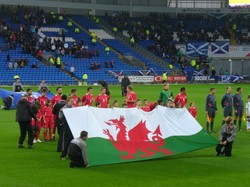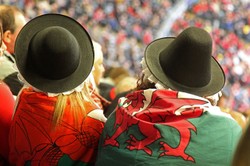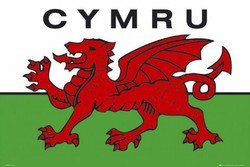In addition, there was renewed interest - and threats - from the Irish Gaels, Scots and Germanic raiders, all of whom saw rich, undefended booty there for the taking.
Later legend says that Vortigern acted alone, but the near contemporary histories talk about a 'council' supporting him all the way. It would seem that a consortium of high-ranking Romano-Celts panicked and made a decision with major consequences; not least the fact that you're reading this in English.
Vortigern and his council invited two Saxon mercenaries to bring three shiploads of warriors into Britain. They would fight on behalf of the Romano-Celts against the British and all comers. They would be given land to facilitate their needs.
Hengist and Horsa established their bases, and quickly realized the truth of the situation. The Romano-Celts were weak. The British Celts were divided. In short, a united front of Germanic tribes from Jutland, Saxony and Angeln (Schleswig-Holstein today) could probably take it all.
Messages flew back across the North Sea and more ships sailed over the horizon in response. The fighting was fierce (Horsa was killed helping the Jutes take modern day Kent from the Cantii), but with startling speed much of the south of Britain became Angle-land - England.
Thousands of Celtic refugees fled over the Channel into Lesser Britain (Britanny); others stayed and integrated with their Anglo-Saxon overlords.
As for the Romano-Celts, their leaders were all invited to a massive conference in London. It was supposed to be free of all weapons, but the Saxons each had a knife concealed about their person. At a signal, halfway through the welcoming feast, all of the Germanic warriors killed the Romano-Celt beside them. Only Vortigern survived, kept alive for his ransom and his standing as a mouthpiece in future campaigns to take the rest of the Isles.
The white dragon was invited into Britain; and the Celts didn't realize the danger until it was way too late. Nor did the Romans return to save the Romano-Celts.
But half lost in the mists of Celtic lore was an answer to it all. The ravages of the white dragon could be held back, if the red dragon rose to meet it.



























 St Tydecho's Churches in West Waleson 09/03/2014
St Tydecho's Churches in West Waleson 09/03/2014
 Goodies for an Outlander Premiere Partyon 03/06/2015
Goodies for an Outlander Premiere Partyon 03/06/2015
 Holocaust Memorial Day Interview with Rainer Höss, Grandson of Rudolf Architect of Auschwitzon 01/24/2015
Holocaust Memorial Day Interview with Rainer Höss, Grandson of Rudolf Architect of Auschwitzon 01/24/2015
 Romantic Valentine Gifts for an Outlander Fanon 01/16/2015
Romantic Valentine Gifts for an Outlander Fanon 01/16/2015



Comments
It was close enough though! If you'd gone for Aberavon (Aber - mouth of the river; Afon - river) you'd have nailed it!
Confusing! And I studued philology too...
Close, but there's some contractions there. 'Gaer yn ar Fon', with Fon being a mutation from Mon, or Anglesey. The fortress over the water from Mon.
As in Caenarfon, the building by the river?
Not to mention the River Avon (Afon, pronounced Avon, being Welsh for river). I talked about some of them here: http://wizzley.com/lost-in-translatio...
Such things always amuse me.
The claim that there are not many Celtic words in English runs foul of the fact that the variety of English that we speak is South Eastern, the area where Saxon dominance was strongest and Celtic the least spoken. But there were other forms, such as Wessex and the Angle dialects of the north and midlands, to which Kentish is related. These would have more Celtic words than south eastern would.
Some place names in Lancashire and the Pennines show Celtic influence. How many hills have pen in their name [e.g. Pendle, Pen y Ghent?] There is in South Lancashire a town called Ince, which means island, close to the Celtic inys/innis. There is a river Douglas near Wigan, Dhu Glas [Dark Stream.] Chat Moss, the large town near which Ince is situated, means wooded moss, chet/chat being old Celtic for woodland. Ince was an island near the edge of the swamp.
There are some hybrid names, which suggest that English and Celtic words flourished for a while at the same time. For example, in Ashton under Lyne there is a steeply sloping road called Penny Meadow, [Pen y Meadow] the high meadow.
Frank - Re Mum and Dad. I was telling Ember last night about Celtic words in the English lexicon. I stopped at Nan, without considering the most fundamental ones of Mum and Dad.
Edward III introduced the St George cross partially because of its manliness - it was the soldier's cross, ergo The Crusades - but also because this was the period when the Welsh really did start raising Y Ddraig Goch and fighting under it.
Yes, I had neglected to mention them. Thanks, Frank! There's some thought that their messages back home accounted for the Saxon attacks in 408, which were repealed by the Celts.
One forgotten element in the equation was the remaining garrisons. In the third century the Roman army had been reorganised into field troops, who could go anywhere, and garrison troops, who were a permanent settlement. Many garrison troops in Britain were imported Germans. There seems to have been many around Lincoln.
The field troops were withdrawn, but the garrisons, who were communities intermingled with the local population, remained long after the official departure date of Rome, trying to repair decaying fortresses until they abandoned them.Robyn Fleming tells of garrisons surviving on Hadrian's wall, long after the Roman departure. Much of the Germanic ten per cent could come from these groups of foederati/laeti/tributarii, as they were variously known.
Britain at that period was in a state of mayhem, with small kingdoms developing and collapsing, with local warlords and garrison commanders taking power and losing it, until these smaller states coalesced into the better known larger ones.
Ember - I recall you saying at the time that it felt different in Wales than it did it Yorkshire, West Sussex and London. To me, there is a definite energy to a place, which might be in the visual clues, but might equally be the place itself. I felt the same changes traveling across America too.
I'm glad to have interested you so much in the subject!